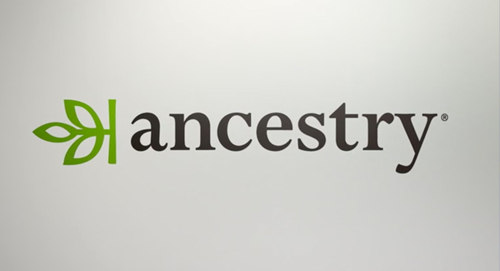Ancestry was founded in 1983 as a genealogy newsletter and has grown into a public company with more than 2.5 million paying customers, 1,400 employees, and $850m in ARR.
It wasn’t by chance that they managed to grow to such scale.
Ancestry gets roughly 52M uniques per month, and this is their traffic breakdown:

In this growth study I reveal the exact tactics they have deployed that you can use to create exponential growth in your SaaS business.
Choose an Ancestry SaaS growth hack to begin:
#1 The Direct Response Curiosity Hook
#2 The SEO Machine That Generates 1.8M Visitors a Month
#4 The Website Acquisition Growth Multiplier
#5 The Backdoor Entrance To Your Subscription Model That Converts At 15%
#6 The We’ll-Give-You -The-Coupon Hack
#1 The Direct Response Curiosity Hook
Ancestry’s mission is to help others discover their story and to do so they spend millions on native advertising every month, primarily through Facebook, Taboola, Outbrain, Revcontent and Yahoo Gemini.
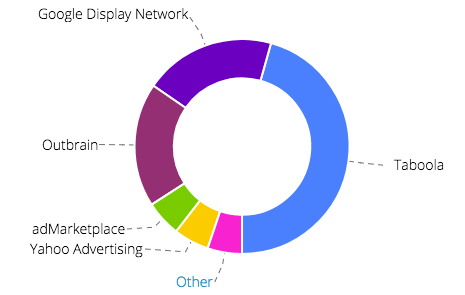
They don’t just create brand awareness or amplify their content, they generate sales through direct response.
How do they do it?
These are their top 4 ads, currently being run on Taboola:
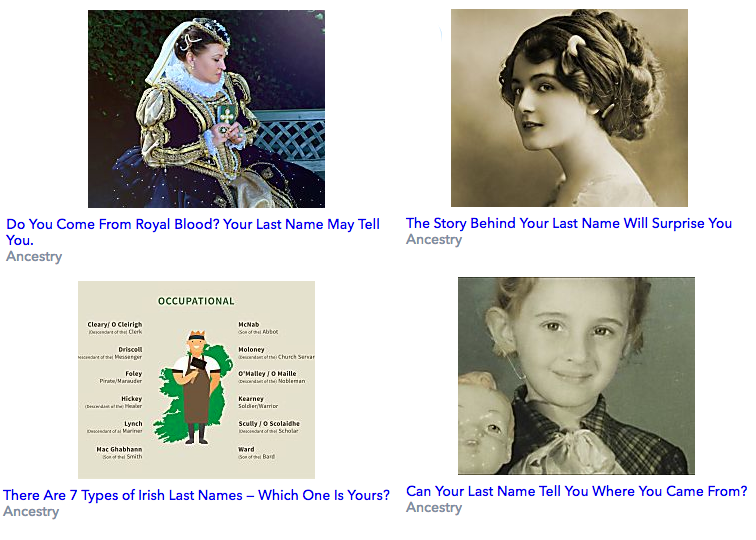
They primarily uses faces in their creatives, rhetorical questions and get users thinking “What discoveries could I make?” in order to incite clicks.
This is important because CTR is Taboola & Outbrain’s version of Facebook’s “Relevancy Score” metric that decreases average CPC and amplifies reach.
For the Google Display Network, they have a similar approach, and add a button and text to the creative:
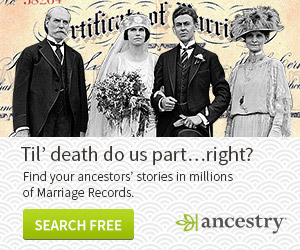
Now Ancestry has fed the ad networks algorithms and got huge reach and CTR, how do they convert this traffic?
The send the users to native blog content that has been specifically optimised for conversions – it’s not your typical blog post layout.
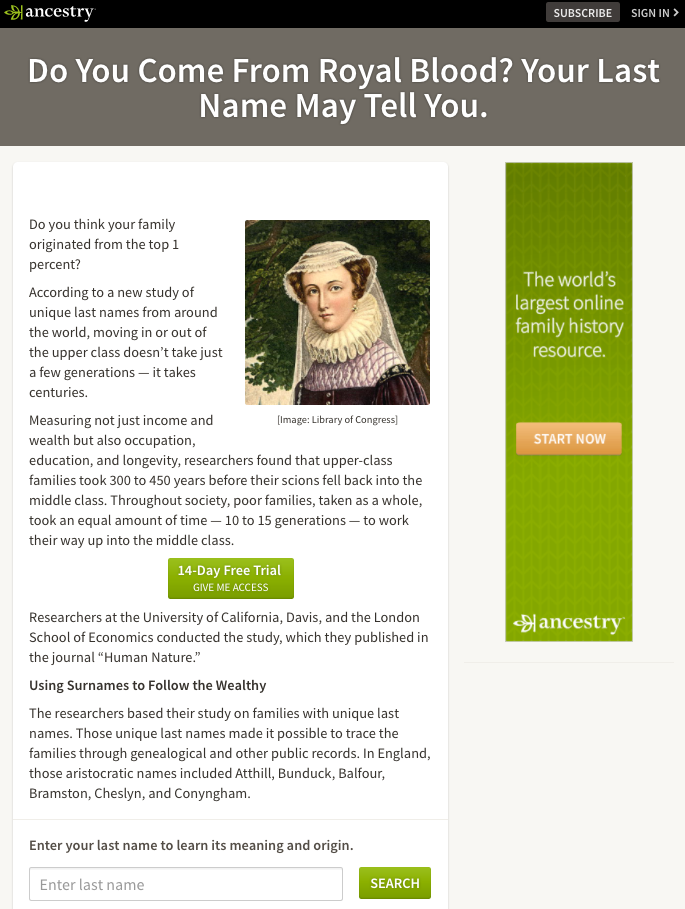
This is what they have done to optimise their conversion-focused blog post :
- Remove menu items from the header
- Push as much content above the fold a possible by decreasing the header height
- Use of green on the action they want the user to take: search or sign up for a free trial.
- They give two options (search vs. free trial) depending on the stage in the funnel the user’s in: completely cold traffic will search, whilst those with brand recall may start a free trial.
- Sticky banner on the right that follows you as a you scroll through the content.
- Search box that leads into the search flow (see growth hack #3 for the flow)
#2 The SEO Machine That Generates 1.8M Visitors a Month
Ancestry’s .com domain gets 4.2M visitors from organic search every month, and 76% of this traffic is from their www. subdomain.
Here’s a breakdown of how much organic traffic each of their primary subfolders get:
| Subfolder | Traffic | % of Total |
| /name-origin/ | 1,830,000 | 56.25% |
| / | 377,000 | 11.78% |
| /genealogy/ | 280,000 | 8.75% |
| /dna/ | 176,000 | 5.50% |
| /1940-census/ | 167,000 | 5.22% |
| other subfolders | 152,700 | 4.77% |
| /secure/ | 117,000 | 3.66% |
| /learn/ | 81,700 | 2.55% |
| /family-tree/ | 48,600 | 1.52% |
That’s 1.8M to their /name-origin/ subfolder, and astoundingly it has 1.05 million subpages, meaning that each page on average receives just 1.7 organic search visitors per month.
Every page has exactly the same structure and copy – the only differences are the facts that have been pulled in to make each page unique.
Thats because Ancestry have uploaded an initial list of around 1 million surnames, and using their data they have created 1 million dynamic pages with generic copy but unique facts on each one.

Take a look at their highest traffic page generating around 5.4k visitors per month. Observe how the page is a mini-fact file that has been dynamically created.
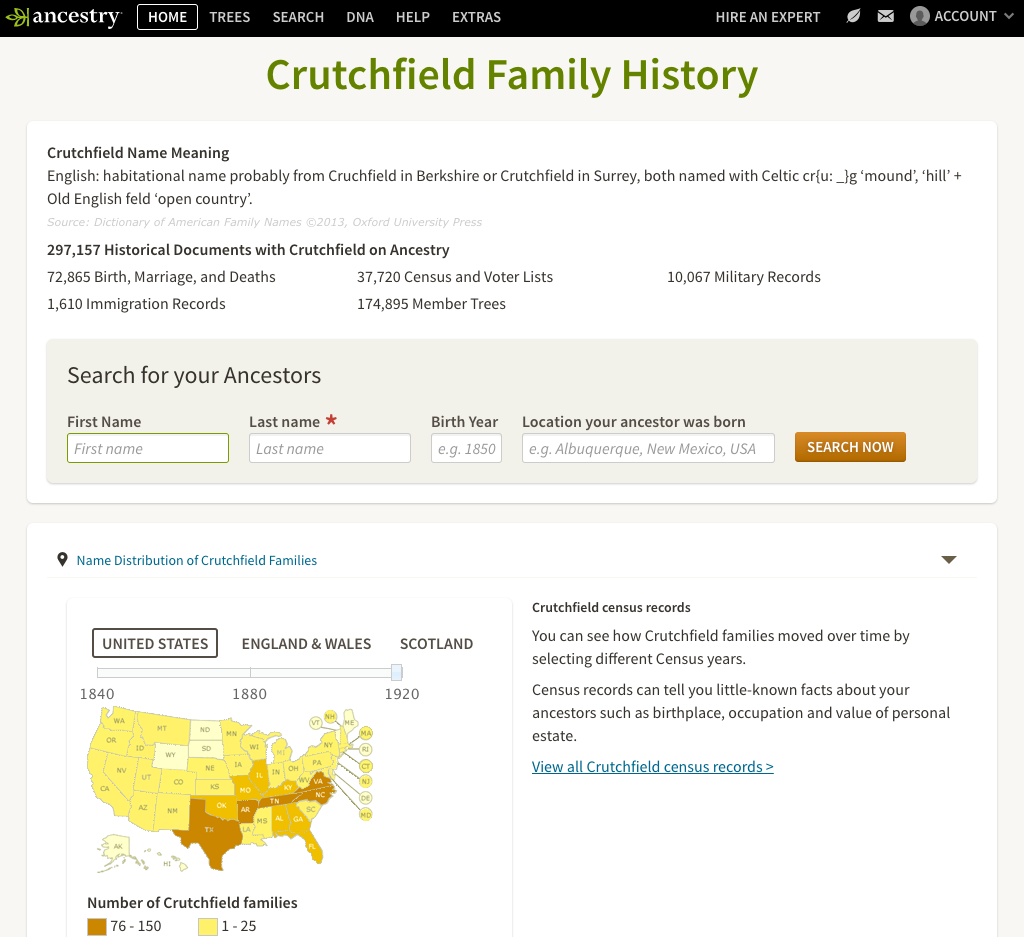
Moreover it’s a self-growing SEO machine, as they collect more historial records they add new surnames to their database. For example, their /name-origin/ subfolder has grown 87% in the past 12 months from 980k to 1.83m monthly organic visitors.
What does all this traffic mean for Ancestry? Here’s an idea on how many new monthly customers they could be generating from these 1 million auto-generated pages:
| Visitors | Visitor -> Search | Searches | Search -> Trial | Trials | Trial -> Subscribe | New customers | ARPA | New Bizz MRR |
| 1.8M | 30% | 540K | 4% | 21.6K | 60% | 12,690 | $20 | $259K |
That’s adding on $3.1m in yearly ARR every month – and just from their US website! They have another 9 localised websites in 6 different languages.
But none of these 1M+ subpages interlink to each other, so what is Ancestry’s linking strategy to get all of these pages to generate 1.8M pageviews per month?
Apart from having around 4k referring domains, with an average growth of 25% year on year, Ancestry created a directory for all of their surnames, www.ancestry.com/learn/facts/ , which is linked from their homepage where the majority of their domain authority is stored.
It’s important to note that Ancestry’s very business model is based on data, in the form of historical records (learn how in growth hack #4). Without data they wouldn’t be able to create these landing pages and attract 1.8 million visitors a month from organic search.
Here are some common examples of this database SEO technique: :
- Theme directory
- App Directory
- Dictionaries
Does your business store data that can be made into auto-generated pages?
#3 The Product Value Teaser
Ancestry’s landing pages tease the product and create a desire before asking for personal information, to convert cold traffic into leads.
How do they do it?
Take a look at this PPC landing page for the keyword “birth records” (Ancestry spends around $350k a month on paid search, to their US site, and has around 340 different landing pages).

Not only do their paid search team increase conversion rates by dynamically inserting the state in which the user is in (see the H2?), but they tease the user by getting them to make their first search.
This uses the commitment principle to get signups – users are more likely to follow through with an action if they previously have entered in some kind of information.
Take a look what happens when I enter in my search information and hit the green button:
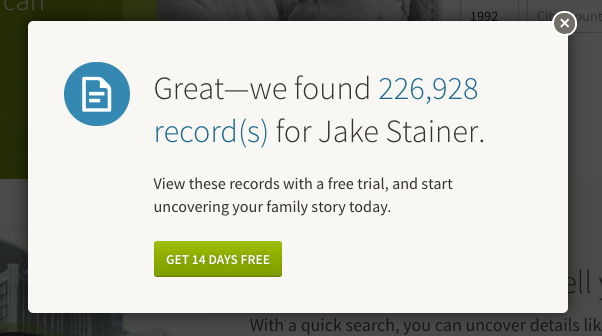
Ancestry gives a peek of the value they are offering, in exchange for starting a free 14 day trial – 226,928 records that are loosely related to my name.
Moreover, another optimisation which Ancestry have deployed in their search ad copy, is telling you what steps they want you to take once you have clicked through.

This increases follow-through rates of the desired action: making a search and starting a free trial. Have you tried this in your paid search ads?
On the other hand, on their organic search pages, they also use the product value teaser technique – but with a much longer flow.
Take a peak:
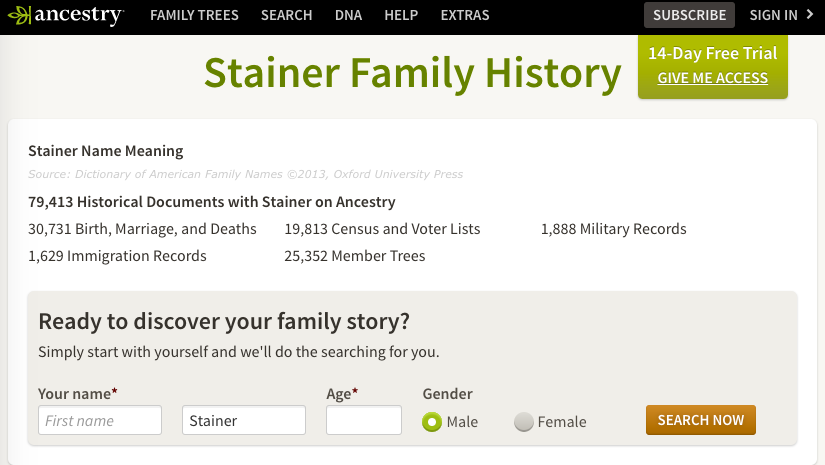
On these SEO pages they also ask for information to perform a search, however instead of asking the user to sign up for a free trial straight away – they ask for even more information:
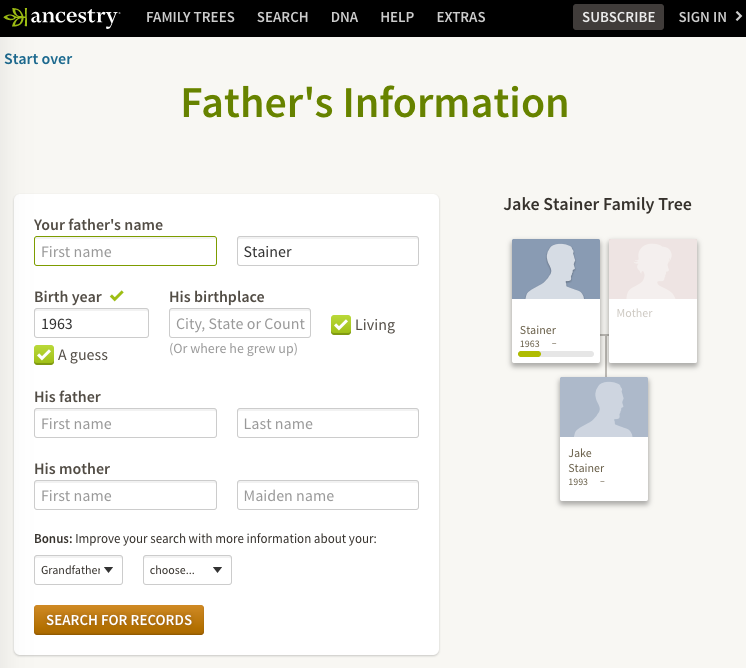
Once the user gives even more information, they then ask for an email to sign the user up.
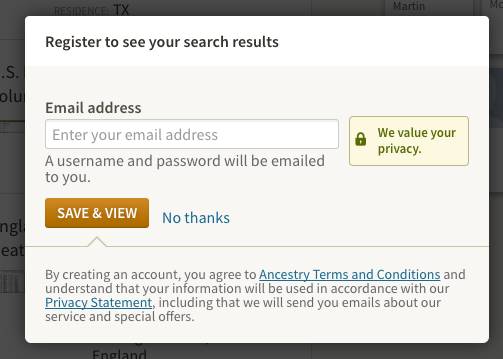
Why is the lead generation flow on paid search different? Here are some ideas:
- The paid search traffic is a lot warmer, they are already thinking about creating a family tree and have more motivation – therefore a shorter flow is needed. (Solution aware vs. problem unaware/curious)
- The paid search team have a higher expectation on ROAS, and therefore try and get a trial as soon as possible to increase conversion rates.
- As a user goes deeper into their website, it decreases the probability that they will arrive back on the SERPs, and this impacts their SEO positively because Google think that the user’s search query has been answered successfully.
I have found no evidence of Ancestry trying the flow they use for paid search, on their organic search pages – its something they should consider A/B testing. However I expect it converts cold traffic much better and even improves their organic search rankings.
#4 The Website Acquisition Growth Multiplier
As mentioned previously, the acquisition of records is helping to increase Ancestry’s organic search reach. The more records they have, the more their organic traffic growths.
In order to do this, Ancestry has acquired multiple websites, for example:
- Archives.com
- Family Tree Maker
- Find a Grave
- Fold3
- Newspapers.com
- Rootsweb
Take a peek at how much traffic these websites get that are feeding into Ancestry’s main funnel:
| Website | Organic Traffic |
| Archives.com | 24,400 |
| Family Tree Maker | 66,200 |
| Find a Grave | 2,000,000 |
| Fold3 | 80,500 |
| Newspapers.com | 467,000 |
| Rootsweb | 38,400 |
Not only has this increased the amount of records, but also the amount of backlinks pointing to their domain.
This combination is not only a growth multiplier for their SEO strategy, but also:
- Decreases churn because customers can find the data they need to build their trees and therefore stick around for longer.
- Allows them to cross sale other subscriptions horizontally (e.g. Newspapers.com) that their audience is interested in. By increasing their customer’s lifetime value, they are able to invest more in paid advertising – and who can spend the most to acquire a customer ultimately wins.
- They cross-promote their core Ancestry offering to these audiences
#5 The backdoor entrance to your subscription model that converts at 15%
Demand for DNA kits have been growing significantly in the past couple of years.

As humans, we’re obsessed with self identity, and DNA testing has been made popular by top mainstream television shows such as Who Do You Think You Are?
Ancestry are capitalising on this trend and have diversified their offering with DNA Kits, AncestryDNA, that the sell for $99 each.
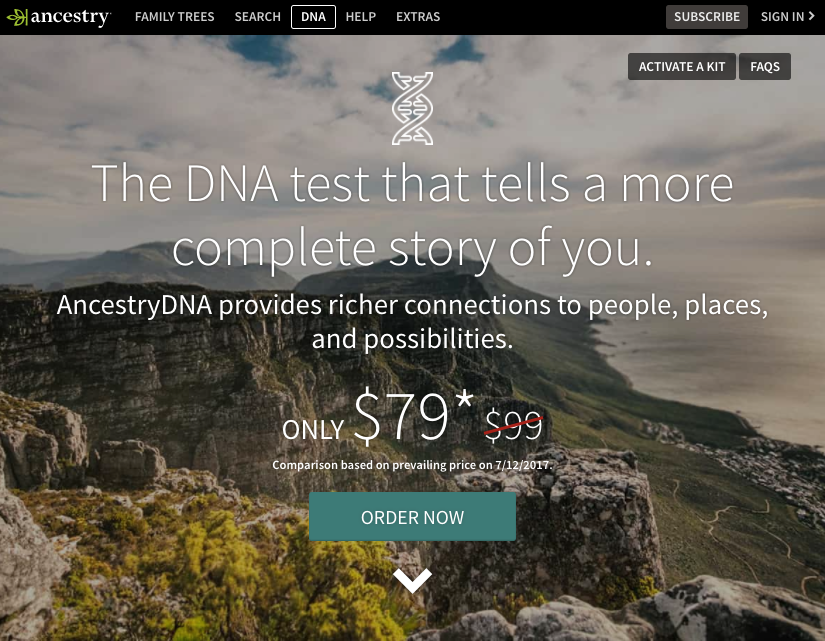
And as the growth in DNA has exploded, this has fed into their core family tree business, with 15% of people who purchase AncestryDNA converting to subscribers.
During Black Friday in 2016, Ancestry sold 1.5M DNA Kits – this means that they also acquired 225,000 new subscribers which is $5.4m in New ARR from a 4-day promotion!
#6 The We’ll Give you the Coupon Hack
Most SaaS businesses have tried using discounts to increase customer acquisition, so have you right?.
Let’s think about it, most eCommerce companies use them, and we are inundated with them on daily basis.
But coupons aren’t easy to manage if you are using them in various channels in various different marketing initiatives.
Not to mention if people see a huge CTA to add a coupon during checkout, most users will search for coupons on Google.
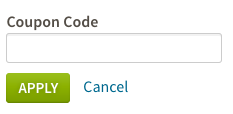
Not only can they get distracted and not return to the checkout process, disillusioned because they can’t find a coupon – coupons will devalue your brand and they decrease your ARPA which is paramount for increasing your LTV and margin for growth.
In order to combat this situation, Ancestry has created a coupon landing page to rank above other coupon websites and blogs in organic search.
They even spends $2k a month on paid search ads to make sure they don’t lose out on revenue through competitor paid ads and organic search results.
Take a look at their coupon landing page:

What’s more, they don’t want to lose revenue to their affiliate partners who rank for branded searches and incentivise their audience with coupons.
They are also acquiring new customers through daily deal sites such as Groupon who usually bid on branded terms through paid search to “cream off” users who were about to convert, anyway.
This coupon page is a key way to minimise loss in revenue and increase margins so that they can invest in other paid channels such as paid search and native ads because they can afford a higher CPA.
#7 The Anti-Churn Guilt Trip
Churn is one of the biggest killers of SaaS businesses, and Ancestry more than knows this; your Monthly Net MRR Churn % is a key metric that dictates your LTV and thus how much you can invest to acquire a customer.
When you hit their cancel subscription page, you see this:
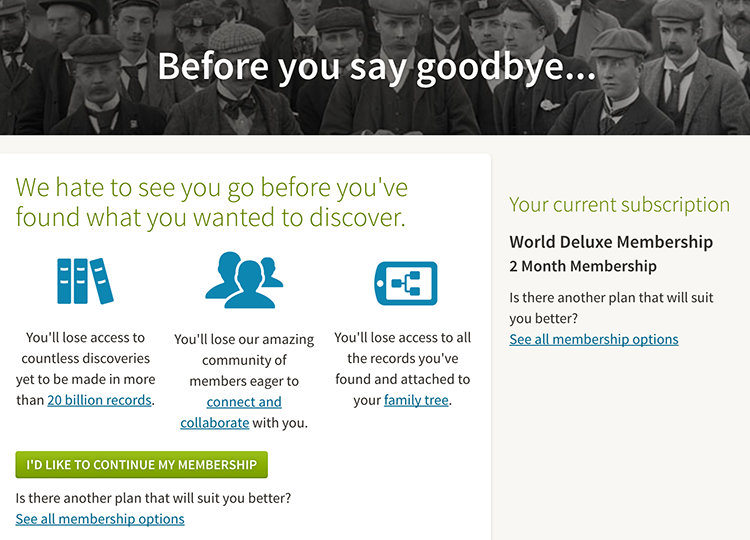
And if you scroll you’ll see the following:
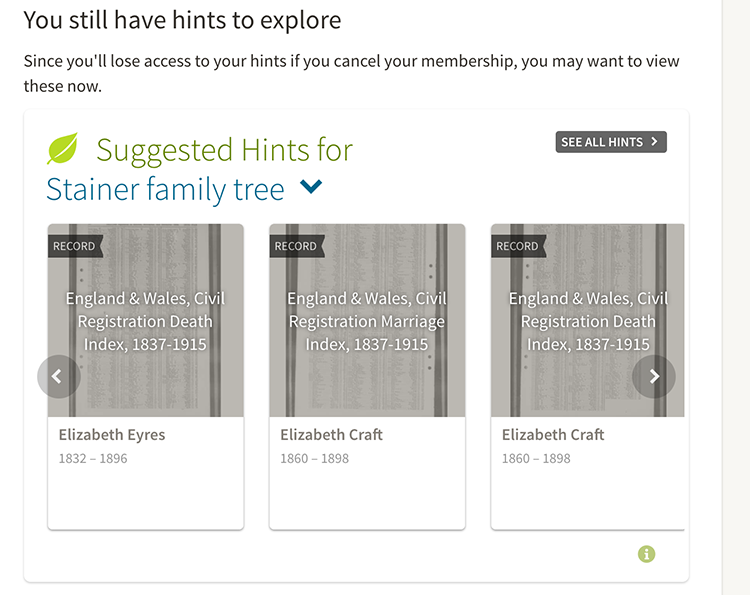
They deploy multiple churn battling tactics on this one page:
First, they capitalise on the investment principle: the more their users invest in building their family trees, the increased sense of loss they will feel when they unsubscribe. They list exactly what you’ll lose when you cancel and include links to push you back into their product.
Second, they persuade you to go back into their product with deep personalised links with hints for your family tree. They anticipate that many users may unsubscribe because of the difficulty of building their family tree, and this may ease this particular pain point.
Third, they let you change your subscription and reiterate the benefits that you get for paying when clicking on “See all membership options”.
Lastly, they use dark patterns in the form of a prominent green continue button that doesn’t cancel your subscription, yet takes you back to your family tree.

Do any of Ancestry’s marketing hacks apply to your SaaS business? Let me know in the comments below.

